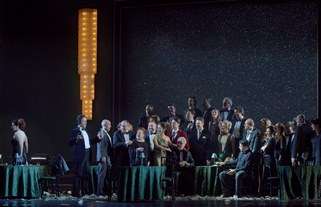|
Back
Violetta and the Paparazzo Venezia
Teatro La Fenice
01/04/2019 - & January 5, 13*, 20, 26, 30, February 1, 3, March 27, 28, 29, 31, April 2, 3, 5, 6, 2019
Giuseppe Verdi: La traviata
Francesca Sassu*/Irina Dubrovskaya/Francesca Dotto (Violetta Valéry), Matteo Lippi*/ Ivan Ayon Rivas/Matteo Desole (Alfredo Germont), Luca Grassi*/Simone Albergini/Armando Gabba (Giorgio Germont), Elisabetta Martorana*/Chiara Brunello (Flora Bervoix), Sabrina Vianello (Annina), Enrico Iviglia (Gastone), Armando Gabba*/William Corrò (Il barone Douphol), Francesco Milanese (Il dottor Grenvil), William Corrò*/Matteo Ferrara (Il marchese d’Obigny), Enrico Masiero*/Salvatore Scribano (Giuseppe), Umberto Imbrenda*/Franco Zanette (Un domestico di Flora), Carlo Agostini*/Nicola Nalesso (Un commissionario), Lorena Calabrò, Gianluca D’Aniello, Christian Di Maio, Kal Guglielmelli, Costantino Imperatore, Angelo Menolascina, Rosalia Moscato, Giulia Mostacchi, Valentina Murante, Andrea Carlotta Pelaia, Erika Rombaldoni, Ilario Marco Russo, Francesco Scalas, Chiara Vittadello (dancers)
Coro del Teatro La Fenice, Ulisse Trabacchin*/Claudio Marino Moretti (chorus master), Orchestra del Teatro La Fenice, Sesto Quatrini*/Francesco Lanzillotta (conductor)
Robert Carsen (stage director), Patrick Kinmonth (sets & costumes), Philipe Giraudeau (choreography), Robert Carsen & Peter van Praet (lighting)

(© Michele Crosera)
It often bothers the operagoing public to watch performances featuring modern costumes and sets. An evening at the opera is often seen as an occasion to be enchanted and transported to the past, and to experience lavish sets and costumes. Robert Carsen’s choice of transposing the setting to an unspecified modern period (late sixties to possibly the present) did not augur well for those yearning for period costumes and the elegance of yesteryear. Act I opened to Violetta in seductive poses on a huge bed. Several men visited her bed as if it were an altar, and paid cash. They hovered around her bed while others presented their offerings. This charade presented the essence of Carsen’s view: Violetta is a prostitute, no question, and the pecuniary aspect of sex surely destroys love. This may be a crusading view, especially in our liberal times, but it is a valid approach. It sharply contrasts with the many sanitized portrayals of Violetta as a reluctant courtesan. Alfredo in this updated setting is a photographer, evocative of Michelangelo Antonioni’s Thomas in the 1966 film Blow-Up, or a paparazzo in another critique of contemporary mores.
Act I opens to Violetta’s party, taking place in her bedroom with several guests behaving obscenely, a far cry from the usual faux-chic bourgeois setting. The sets for the first scene of Act 2 are usually a posh country home. But here, Carsen has transported the scene to an autumnal forest. Bank notes are on the ground, in lieu of autumn leaves. Violetta is having a picnic when Giorgio Germont arrives. The lack of the usual furniture makes the confrontation harsher as Violetta has no material belongings surrounding her as figurative armour against Germont Sr’s verbal assault. However, the open space did not produce the intended claustrophobic effect a closed room affords. Moreover, some of the libretto (“Pur tanto lusso”) fell flat.
In the second scene, Flora’s place was not set in her home but rather a nightclub. For once, the gypsy girls and the toreadors’ dances made sense, being on a stage in the club. A brilliant stroke was having Alfredo’s humiliation of Violetta (“Questa donna conoscete”) and Giorgio Germont’s rebuking of Alfredo (“Disprezzo degno”) take place onstage, with the voyeuristic nightclub audience attentively watching, almost cheering. This is a clin d’œil to today’s obsession with celebrity-watching, exhibitionism and social media overkill, as well as a fitting role reversal for the paparazzo, Alfredo.
The theme of money was ubiquitous throughout the production. It is thrown at Violetta on every occasion. This contrasts sharply with her squalid dwelling in Act 3; it seems she’s had to sell most of her trendy apartment furniture. The prelude to the final act opens to Violetta reduced to sleeping on the floor in front of her television. The place seems to be partially used as a warehouse or perhaps being renovated for a future tenant. Her regal bed is no more, a metaphor for the cessation of her profession.
La Fenice’s cast was a strong one. Matteo Lippi, as Alfredo, has a beautiful timbre but perhaps an insufficient elegance of style. He tended to sing forte much of the time, which is compatible with a provincial young man transplanted in the big city. Luca Grassi, as Giorgio Germont, also tended to sing forte, but managed to make a strong impression in his confrontation with Violetta. Francesca Sassu, as Violetta Valéry, was dramatically convincing despite her light coloratura voice. This role, one of the repertoire’s most demanding, is often mistaken for an essentially coloratura role due to the high notes of Act 1’s “Sempre libera,” but it is much more. It demands a lyric soprano with a coloratura’s agility as well as a dramatic temperament and charisma for the confrontation with Giorgio Germont and the tragic last act. It was a joy to experience Sassu in “Sempre libera,” where she brilliantly sang the high notes. She was also effective in Act 3’s “Addio del passato.” However, she was not vocally convincing in the dramatic moments of the opera, such as the act 2 duet, “Dite alla giovine,” nor in the death scene of the final act, “Prendi questa è l’immagine.” Crucial phrases such as “Amami Alfredo quanto io t’amo” in Act 2, “Morrò! ... La mia memoria, non fia ch’ei maledica” in Act 3 were not sufficiently dramatic with her soubrette’s voice.
Sesto Quatrini conducted La Fenice’s orchestra with variable dexterity. The prelude to Act I was clearly well-rehearsed, while tempi were too slow during the Act 2 Violetta-Germont Sr. confrontation. The choreography in the second act dances was appropriately kitsch. The toreadors were provocatively clad cowboys, and their moves lascivious.
Ossama el Naggar
|